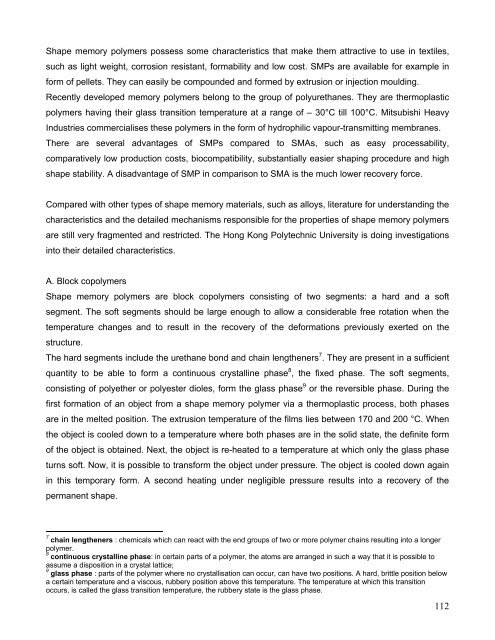Clevertex - Grado Zero Espace Srl
Clevertex - Grado Zero Espace Srl
Clevertex - Grado Zero Espace Srl
Create successful ePaper yourself
Turn your PDF publications into a flip-book with our unique Google optimized e-Paper software.
Shape memory polymers possess some characteristics that make them attractive to use in textiles,<br />
such as light weight, corrosion resistant, formability and low cost. SMPs are available for example in<br />
form of pellets. They can easily be compounded and formed by extrusion or injection moulding.<br />
Recently developed memory polymers belong to the group of polyurethanes. They are thermoplastic<br />
polymers having their glass transition temperature at a range of – 30°C till 100°C. Mitsubishi Heavy<br />
Industries commercialises these polymers in the form of hydrophilic vapour-transmitting membranes.<br />
There are several advantages of SMPs compared to SMAs, such as easy processability,<br />
comparatively low production costs, biocompatibility, substantially easier shaping procedure and high<br />
shape stability. A disadvantage of SMP in comparison to SMA is the much lower recovery force.<br />
Compared with other types of shape memory materials, such as alloys, literature for understanding the<br />
characteristics and the detailed mechanisms responsible for the properties of shape memory polymers<br />
are still very fragmented and restricted. The Hong Kong Polytechnic University is doing investigations<br />
into their detailed characteristics.<br />
A. Block copolymers<br />
Shape memory polymers are block copolymers consisting of two segments: a hard and a soft<br />
segment. The soft segments should be large enough to allow a considerable free rotation when the<br />
temperature changes and to result in the recovery of the deformations previously exerted on the<br />
structure.<br />
The hard segments include the urethane bond and chain lengtheners 7 . They are present in a sufficient<br />
quantity to be able to form a continuous crystalline phase 8 , the fixed phase. The soft segments,<br />
consisting of polyether or polyester dioles, form the glass phase 9 or the reversible phase. During the<br />
first formation of an object from a shape memory polymer via a thermoplastic process, both phases<br />
are in the melted position. The extrusion temperature of the films lies between 170 and 200 °C. When<br />
the object is cooled down to a temperature where both phases are in the solid state, the definite form<br />
of the object is obtained. Next, the object is re-heated to a temperature at which only the glass phase<br />
turns soft. Now, it is possible to transform the object under pressure. The object is cooled down again<br />
in this temporary form. A second heating under negligible pressure results into a recovery of the<br />
permanent shape.<br />
7<br />
chain lengtheners : chemicals which can react with the end groups of two or more polymer chains resulting into a longer<br />
polymer.<br />
8<br />
continuous crystalline phase: in certain parts of a polymer, the atoms are arranged in such a way that it is possible to<br />
assume a disposition in a crystal lattice;<br />
9<br />
glass phase : parts of the polymer where no crystallisation can occur, can have two positions. A hard, brittle position below<br />
a certain temperature and a viscous, rubbery position above this temperature. The temperature at which this transition<br />
occurs, is called the glass transition temperature, the rubbery state is the glass phase.<br />
112

















